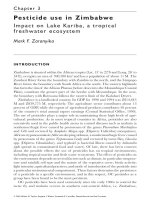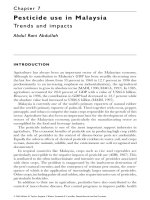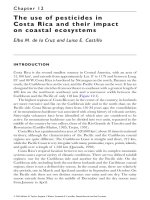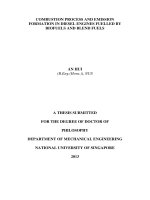Excellence in business communication 12e by vthill and brovee chapter 02
Bạn đang xem bản rút gọn của tài liệu. Xem và tải ngay bản đầy đủ của tài liệu tại đây (758.48 KB, 38 trang )
Copyright © 2017 Pearson Education, Inc.
Excellence in
in
Excellence
Business Communication
Communication
Business
Chapter 2
Collaboration, Interpersonal Communication, and Business
Etiquette
Copyright © 2017 Pearson Education, Inc.
Learning Objectives
1.
(1 of 3)
List the advantages and disadvantages of working in teams,
describe the characteristics of effective teams, and highlight
four key issues of group dynamics.
2.
Offer guidelines for collaborative communication, identify major
collaboration technologies, and explain how to give constructive
feedback.
Copyright © 2017 Pearson Education, Inc.
Chapter 2 - 3
Learning Objectives
3.
(2 of 3)
List the key steps needed to ensure productive team
meetings.
4.
Identify the major technologies used to enhance or replace
in-person meetings.
5.
Identify three major modes of listening, describe the
listening process, and explain the problem of selective
listening.
Copyright © 2017 Pearson Education, Inc.
Chapter 2 - 4
Learning Objectives
6.
(3 of 3)
Explain the importance of nonverbal communication and
identify six major categories of nonverbal expression.
7.
Explain the importance of business etiquette, and identify
four key areas in which good etiquette is essential.
Copyright © 2017 Pearson Education, Inc.
Chapter 2 - 5
Communicating Effectively
Effectively
Communicating
in Teams
Teams
in
(LO 1) List the advantages and disadvantages of working in teams,
describe the characteristics of effective teams, and highlight four
key issues of group dynamics.
Copyright © 2017 Pearson Education, Inc.
Chapter 2 - 6
Advantages of Teams
Increased Information and Knowledge
Increased Diversity of Viewpoints
Increased Acceptance of Solutions
Increased Levels of Performance
Copyright © 2017 Pearson Education, Inc.
Chapter 2 - 7
Disadvantages of Teams
Groupthink
Pressure to Conform
Affects Decision Quality
Hidden Agenda
Restricts Interaction
Limits Productivity
High Cost
Aligning Schedules
Copyright © 2017 Pearson Education, Inc.
Arranging Meetings
Chapter 2 - 8
Characteristics of
Effective Teams
Clear Objective
Full Engagement
Creativity and Technical Skills
Copyright © 2017 Pearson Education, Inc.
Shared Purpose
Consensus
Decision Making
Communication
Chapter 2 - 9
Collaborating on
on
Collaborating
Communication Efforts
Efforts
Communication
(LO 2) Offer guidelines for collaborative communication, identify
major collaboration technologies, and explain how to give
constructive feedback.
Copyright © 2017 Pearson Education, Inc.
Chapter 2 - 10
Guidelines for
Collaborative Writing
(1 of 2)
Select Collaborators Carefully
Agree on Goals Before You Start
Give the Team Some Time to Bond
Clarify Individual Responsibilities
Copyright © 2017 Pearson Education, Inc.
Chapter 2 - 11
Guidelines for
Collaborative Writing
(2 of 2)
Establish Clear Group Processes
Avoid Writing as a Group
Use Compatible Technologies
Seek Feedback from the Team Often
Copyright © 2017 Pearson Education, Inc.
Chapter 2 - 12
Technologies for
Collaborative Writing
ContentManagement
Management
Content
System
System
(1 of 2)
OrganizedApproach
Approach
Organized
ControlledAccess
Access
Controlled
FlexibleApproach
Approach
Flexible
Wiki
Wiki
OpenAccess
Access
Open
Copyright © 2017 Pearson Education, Inc.
Chapter 2 - 13
Technologies for
Collaborative Writing
(2 of 2)
SharedKnowledge
Knowledge
Shared
Groupware
Groupware
CloudComputing
Computing
Cloud
Shared
Shared
Workspaces
Workspaces
Copyright © 2017 Pearson Education, Inc.
Intranets
Intranets
Extranets
Extranets
Chapter 2 - 14
Collaboration via Mobile Devices
Unifed Communication
Voice and Video Calling
Voice and Video Conferencing
Instant Messaging
Real-Time Collaboration
Copyright © 2017 Pearson Education, Inc.
Chapter 2 - 15
Giving and Responding to Constructive
Feedback
Offering Constructive Criticism
•
•
Focus on the process and outcomes.
Provide clear guidelines for improvement.
Receiving Constructive Criticism
•
•
Don’t get defensive or deny the feedback’s validity.
Use the feedback to improve the quality of your work.
Copyright © 2017 Pearson Education, Inc.
Chapter 2 - 16
Making Your
Your Meetings
Meetings
Making
More Productive
Productive
More
(LO 3) List the key steps needed to ensure productive team
meetings.
Copyright © 2017 Pearson Education, Inc.
Chapter 2 - 17
Preparing for Meetings
Careful Preparation and Planning Tasks
•
•
•
•
Clarify the purpose of your meeting.
Select the participants for the meeting.
Choose the meeting’s time and venue.
Set and share the purpose of the meeting.
Copyright © 2017 Pearson Education, Inc.
Chapter 2 - 18
Conducting and Contributing to Efficient
Meetings
•
•
•
•
•
•
Keep the discussion on track.
Follow agreed-upon rules.
Encourage everyone to participate.
Participate in an active way.
Use mobile devices respectfully.
Close the meeting effectively.
Copyright © 2017 Pearson Education, Inc.
Chapter 2 - 19
Sample Meeting Agenda
Copyright © 2017 Pearson Education, Inc.
Chapter 2 - 20
Putting Meeting Results to Productive Use
•Problems and
and Opportunities
Opportunities
•Problems
•Action Items
Items Discussed
Discussed
•Action
Written Meeting
Meeting
Written
Minutes
Minutes
•Key Decisions
Decisions Made
Made
•Key
•Important Announcements
Announcements
•Important
•Responsibilities Assigned
Assigned
•Responsibilities
Copyright © 2017 Pearson Education, Inc.
Chapter 2 - 21
Using Meeting
Meeting Technologies
Technologies
Using
(LO 4) Identify the major technologies used to enhance or replace
in-person meetings.
Copyright © 2017 Pearson Education, Inc.
Chapter 2 - 22
Meeting Technologies
Instant Messaging
Teleconferencing
Virtual Meetings
Videoconferencing
Copyright © 2017 Pearson Education, Inc.
Web-Based Meetings
Chapter 2 - 23
Virtual Meetings
Copyright © 2017 Pearson Education, Inc.
Chapter 2 - 24
Improving Your
Your Listening
Listening Skills
Skills
Improving
(LO 5) Identify three major modes of listening, describe the
listening process, and explain the problem of selective listening.
Copyright © 2017 Pearson Education, Inc.
Chapter 2 - 25









